First published in 1789, Gilbert White’s The Natural History and Antiquities of Selborne describes the history and environment of the parish in eastern Hampshire where White lived for much of his life. Structured as 110 letters to two friends of the author - zoologist Thomas Pennant and amateur naturalist Daines Barrington, the book offers detailed accounts of his observations in passages such as this:
You cannot but remember that the twenty-sixth and twenty-seventh of last March were very hot days, so sultry, that every body complained and were restless under those sensations to which they had not been reconciled by gradual approaches.
This sudden summer-like heat was attended by many summer coincidences; for on those two days the thermometer rose to sixty-six in the shade; many species of insects revived and came forth; some bees swarmed in this neighbourhood; the old tortoise, near Lewes, in Sussex, awakened and came forth out of its dormitory: and, what is most to my present purpose, many house-swallows appeared and were very alert in many places, and particularly at Cobham, in Surrey.
But as that short warm period was succeeded as well as preceded by harsh, severe weather, with frequent frosts and ice, and cutting windes, the insects withdrew, the tortoise retired again into the ground, and the swallows were seen no more until the tenth of April, when, the rigour of the spring abating, a softer season began to prevail. (pp. 241 in the 1832 Whittaker, Treacher, and Co. edition)
Unified by its geographical focus on place, White’s work ranges far and wide in the topics it covers: descriptions of the soil (clay in the southwest and ‘black malm’ in the north-east), the discovery of a rare fossil of a fish typically found in the Indian ocean, a list of annual baptisms and funerals, commentary on poaching and the over-hunting of grouse and red deer.
The Natural History of Selborne was admired by literary and scientific luminaries, including Romantic poet Samuel Taylor Coleridge, who described it as a “sweet, delightful book,” and Charles Darwin, whom it inspired to wonder “why every gentleman did not become an ornithologist.” Indeed, White’s observations of birds were particularly keen. Unlike many of his contemporaries who focused primarily on anatomy and plumage, White gave great attention to the behavior and habitat of birds. By noting the distinct songs of the three British leaf warblers, he became the first to recognize what was previously considered one warbler species as three.
Although White passed away just a few years after publication, The Natural History and Antiquities of Selborne enjoyed enduring popularity. As an early instance of the natural history essay, White’s work served as inspiration and model for 19th century writers of the genre, including Susan Fennimore Cooper, author of Rural Hours(1850) and Henry David Thoreau, author of Walden, or, Life in the Woods(1854). The full onset of the industrial revolution added further attractions to White’s musings, for they met readers’ increasing nostalgia for rural life and their desire to rediscover a pastoral countryside.
Well over 100 English editions of White's work have been published, as well as several translations. The 1832 edition pictured below is locally notable because it forms part of the original library of the University of Michigan, purchased in Europe by Asa Gray between 1838-1839. Published as volume XLV of Constable's Miscellany of Original and Selected Publications, this edition includes White's Natural History only, and not his writings on antiquities. It features a number of engravings of the birds White observed, including the harriers and grey wagtail pictured below.
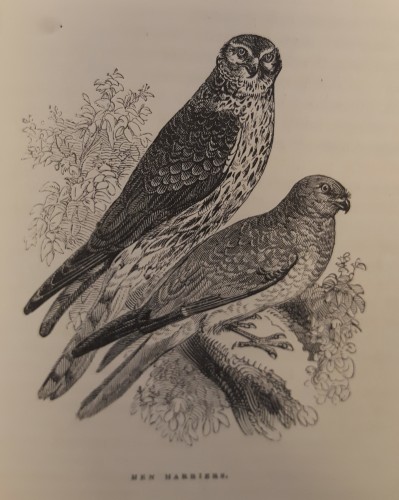
"Hen Harriers" from The Natural History of Selborne by Gilbert White, printed for Whittaker, Treacher, & Co. in London and Waugh & Innes in Edinburgh, 1832. Special Collections Asa Gray Collection QH 138 .S4 W58 1832

"Grey Wagtail" from The Natural History of Selborne by Gilbert White, printed for Whittaker, Treacher, & Co. in London and Waugh & Innes in Edinburgh, 1832. Special Collections Asa Gray Collection QH 138 .S4 W58 1832
Published in 1895, the two-volume D. Appleton & Co. edition is extensively illustrated with photographs of Selborne taken by New England illustrator & photographer Clifton Johnson. It's hard to say, at this chronological distance, whether late 19th century readers would have seen the photographs as an update and expansion of White's original observations, or if the absence of verbal commentary on how landscapes and livelihoods of Selborne changed between 1789 and 1895 meant that these photographs would only have added to the impression of Selborne as a place outside of time, comfortingly isolated from a rapidly changing world.
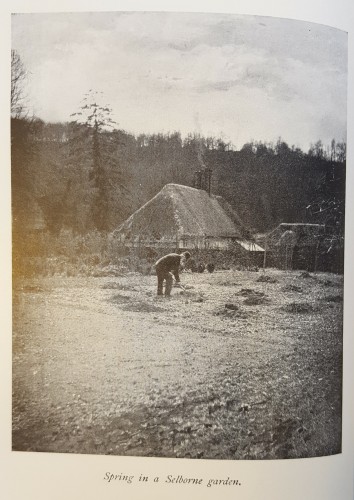
"Spring in a Selborne garden" from The Natural History of Selborne & Observations on Nature by Gilbert White, published by D. Appleton & co. in New York, 1895. Special Collections General and Rare PS 1224 .N3 1895
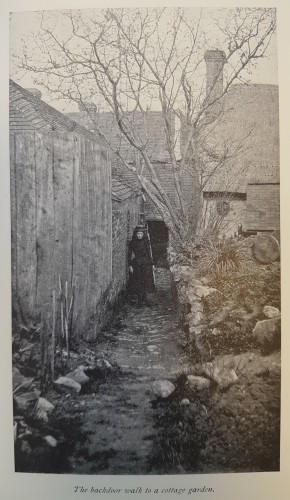
"The backdoor walk to a cottage garden" from The Natural History of Selborne & Observations on Nature by Gilbert White, published by D. Appleton & co. in New York, 1895. Special Collections General and Rare PS 1224 .N3 1895
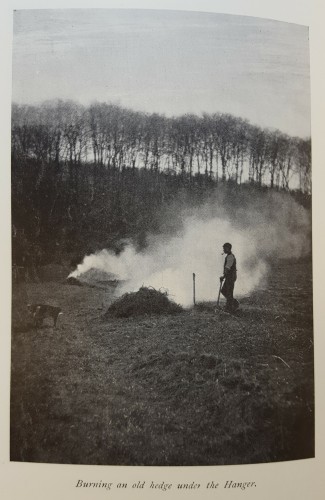
"Burning and old hedge under the Hanger" from The Natural History of Selborne & Observations on Nature by Gilbert White, published by D. Appleton & co. in New York, 1895. Special Collections General and Rare PS 1224 .N3 1895
Gilbert White’s writing has also been an inspiration for fine printers and artists, as exemplified in the two works below. The illustrated 1929 edition issued by T. Butterworth was limited to 125 copies, of which the library holds number 124. In addition to a frontispiece portrait of the Rev. Gilbert White, it includes numerous illustrations from wood engravings by British naturalist, author, and illustrator Eric Daglish, F.Z.S.. Mounted on a fold-out at the front of the book is an original print signed by the artist.

"The Snipe" [original print] from The Natural History of Selborne by Gilbert White, a limited edition of 125 copies published by T. Butterworth in London, 1929. This is copy no. 124. Special Collections General and Rare QH 138 .S4 W58 1929

"Fallow Deer" from The Natural History of Selborne by Gilbert White, a limited edition of 125 copies published by T. Butterworth in London, 1929. This is copy no. 124. Special Collections General and Rare QH 138 .S4 W58 1929

"Cattle Standing in Water" from The Natural History of Selborne by Gilbert White, a limited edition of 125 copies published by T. Butterworth in London, 1929. This is copy no. 124. Special Collections General and Rare QH 138 .S4 W58 1929
More recently and locally, Detroit-based artist Karen Klein created this lovely pochoir print in honor of Gilbert White, which she generously gifted to the library earlier this year. Enclosed in a translucent yellow fold-over, it is accompanied by a card summarizing White's importance as a nascent behavioral biologist.
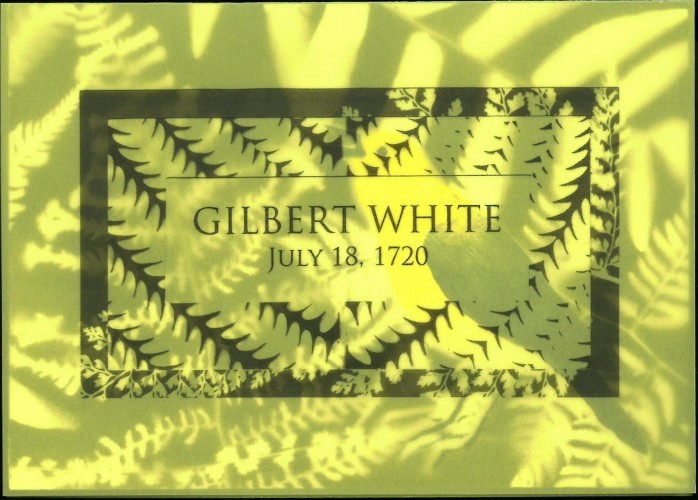
Print in honor of Gilbert White by Karen Klein, Chicken in a Snowstorm Press.
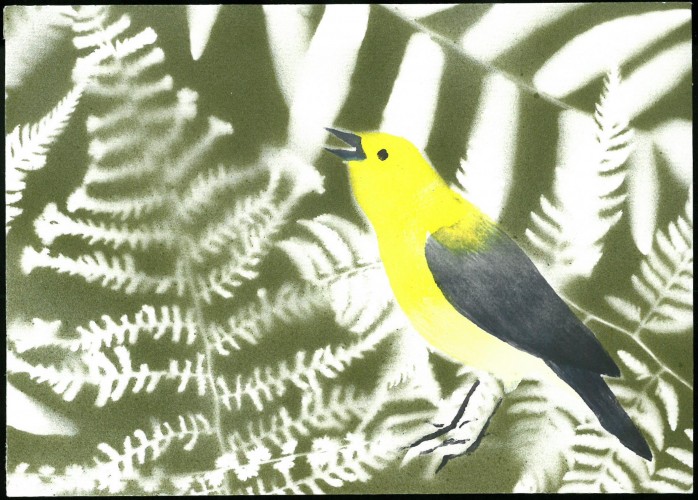
Print in honor of Gilbert White by Karen Klein, Chicken in a Snowstorm Press.
For those wishing to share in Gilbert White’s explorations of Selborne themselves, note that all of these materials may be requested for reading room use, and that the 1832 and 1895 editions are also available online through Hathi Trust.
Bibliography:
Norwood, Vera, “Pleasures of the Country Life: Susan Fenimore Cooper and the Seasonal Tradition,” Made from this Earth: American Women and Nature (1993).
"Overview: The Natural History of Selborne." Gale Online Encyclopedia. Detroit: Gale, 2016. Literature Resource Center. Web. 6 Oct. 2016.
Pickering, Sam, “White, Gilbert (1720-1793), British Writers: Supplement 6. Ed. Jay Parini. New York: Charles Scribner's Sons, 2001. p279-295. From Gale Virtual Reference Library.